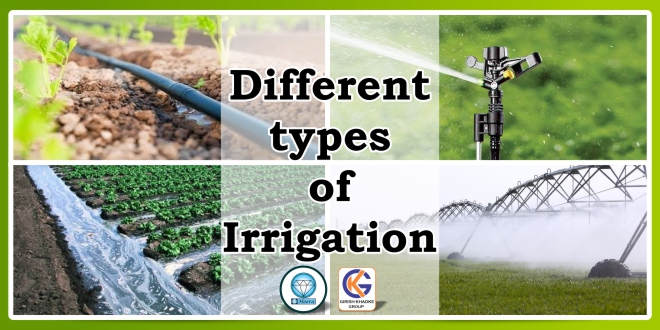IRRIGATION
The process of supplying water to the crops by artificial means such as canals, wells, tube wellis from the source of water such as river, tanks, ponds or ground water is called irrigation. The monsoon rainfall in India is uncertain & highly variable. The temporal & spatial variability of rainfall accentuates the need for artificial supply of water to the crops.
Hence irrigation in India becomes indispensable.
In India, farming practices increase the demand for irrigation in regions with enough rainfall, in addition to the whims of the monsoon. Water for irrigation is needed for some crops, including rice, sugarcane, jute, cotton, and chalk.

According to estimates, under similar geographical conditions, the productivity of crops with irrigation is 50–100% more than that of crops without irrigation.
The green revolution and the introduction of HYV seeds have boosted the demand for irrigation even further.
Reasons for Water Scarcity
The rainfall is highly variable.
◆ 18% of water available is polluted and unfit for drinking. Almost all parts of India are affected either by flood or drought.
◆ Demand for water is increasing due to rapid increase in population.
The management of available water resources in not proper. The storage facilities are very poor.
Over-exploitation of ground water of- ten result in the intrusion of saline sea water in coastal areas.
Cultivation of hybrid varieties of paddy, wheat, cotton, sugarcane and tobacco which consume
more water. ◆ Evaporation loss of water stored in large reservoirs and loss by seepage in long canal systems.
Siltation of water bodies.
◆ Dumping of various types of pollutants into water bodies reduce its usability. The source of irrigation depends upon the water availability, topography, reliel, availability of soil and moisture, requirements of crop. Important sources of irrigation in India include:
Wells:
Wells are the most basic sources of irrigation in India.
It depends upon the availability of ground water.
The Great Plains, the deltaic regions of the Mahanadi, Godavari,Krishna and Cauvery are important regions of well irrigation.
Tanks:
situated on the Peninsula’s rugged area.
Since the tanks are not permanent, more water is required in the summer.
Tank irrigation makes up about 11% of India’s net irrigated area.
This type of irrigation is used in the Karnataka plateau, coastal Maharashtra, Andhra Pradesh, and Tamil Nadu.
# Canals:
India has one of the world’s largest areas under canal irrigation.
About 40% of the net irrigated area comes under canal irrigation.
Uttar Pradesh, Punjab, Haryana, Rajasthan, Bihar, Andhra Pradesh are the main regions.
Multi-purpose projects alm at:
a) Flood Control
b) Promotion and operation of irrigation schemes, water supply.
) Generation and Transmission of electric power
d) Promotion and control of irrigation
e) Afforestation and other economic activity generation.

For the better utilization of the total potential the irrigation schemes have been divided into:
Multi-purpose Project
I) Major Projects: Cultivable command area of more than 10,000 hectare, (including canal irrigation)
2) Medium Project: Cultivable command area between 2000 and 10000 hectare.
3) Minor Projects: Cultivable command area less than 2000 hectare, include mainly well irrigation.
4) Micro Projects: Drip irrigation and the use of sprinklers.
In Punjab 75% of the net sown area is irrigated, in Haryana & U.P. this ratio is of about 57%, in TN About 49% in U.P. about 38%, in Maharashtra only 9% are irrigated.
MAJOR IRRIGATION & POWER PROJECTS:
1. Bhakra-Nangal Project: Joint venture of Punjab, Haryana & Rajasthan; on river Sutlej: Bhakra Dam is the highest straightway gravity dam in the world with a reservoir named ‘Govind Sagar lake’. Nangal Dam is 13 km downstream of Bhakra dam. It has four power houses (total 1204 Mw) at Gonguwal, Kotta, Left Bank & Right Bank.
2. Rihand-Dam Project: Across river Rihand on MP-UP border in Mirzapur District. Rihand is the largest man-made lake in India; reservoir is known as ‘Govind Ballabh Pant Sagar’.
3. Chambal Project: A joint venture of Rajasthan & MP; on river Chambal comprises there dams Gandhi Sagar Dam (MP). Rana Pratap Sagar (Rajasthan), Jawahar Sagar (Rajasthan).
4. Gandak Project: A joint venture of UP & Bihar & Nepal; on Gandak river; a barrage near Valmiki Nagar.
5. Nagarjuna Sagar Project: On Krishna River near Nandikonda village in Andhra.
6. Kosi Project: On River Kosi; a joint venture of Bihar & Nepal, a barrage near Hanuman Nagar in Nepal.
7. Tungabhadra Project: A joint venture of Andhra & Karnataka; on river Tungabhadra.
8. Beas Project: A joint venture of Punjab, Haryana & Rajasthan; on river Beas; a dam at ‘Pong
9. Hirakund Project: On Mahanadi in Orissa, its dam is longest in the world.
10. Damodar Valley Project: (W. Bengal & Bihar) have a series of small dams on the tributaries of river Damodar ie. Tilaiya (R.Barakar), Konar (R. Konar), Maithan (R. Barakar), Panchet (R. Damodar) and 3 Thermal Power stations at Bokaro, Chandrapura & Durgapur.
11. Kakrapara Project: on river Tapi in Gujarat.
12. Machkund Project: on river Mach-kund Andhra & Orissa joint venture.
13. Malprabha Project: on river Malprabha in Karnataka.
4. Mayurakshi Project: on river Mayurakshi in W. Bengal.
15. Hansdeo Bango Project: on river Hansdeo in MP
16. Bhima project: have two dams Pawna dam at river Pewna & Ujjatni dam on river Krishna in Maharashtra
17. Jalkawadi Project: on river Godavari in Maharashtra
18. Tawa irrigation Project: on river Tawa, a tributary of Narmada in MP
19. Tihri Dam Project: on river Bhagirathi near Dev Prayag in UP
►IMPORTANT HYDRO ELECTRIC PROJECTS:
1. Tata HEP: on Nila-Mulas river in Maharashtra, power to Bombay.
2. Pykara HEP: TN. on Pykara river in Nilgiri, Ist HEP in T.N
3. Mandi HEP: 1st in Himalayan region on a tributary of Beas.
4. Balimela HEP: Orissa.
5. Ukal HEP: Maharashtra on river Tapi.
6. Salal HEP: J&K
7. Chukha HEP: Bhutan-constructed by India & surplus energy is purchased by India for its NEstates
8. Koyna HEP: Maharashtra on Koyna river at Deshmukh-wadi.
9. Sivasamudram Scheme: In Karnataka at Sivasamudram falls on Cauvery.
10. Sharavati HEP: Karnataka across Sharavati near Jog fall in Shimoga district.
11. Mettur HEP: T.N. Stanley Dam on river Cauvery.
12. Papanasam Scheme: T.N. On Tamraparni river in Tirunelveli district.
13. Sabrigiri HEP: Kerala: Dam across Pamba river.
14. Sarda HEP: U.P. across Sarda river in Nainital district.
15. Idukki HEP: Keralahave three storage dams on rivers Periyar, Cherutheni, Idukki,
16. Kalinadi HEP: Karnataka on Kalinadi river in N. Kanara district.
India’s potential of HEP:
5th after Zaire, Former USSR, Canada and USA.
North-Eastern India has 30% of India HEP potential Himalayan region has 30% of India HEP Potential peninsular
India has 40% of India HEP potential (1/2 in the east flowing rivers rising in the Western Ghats)
We have developed only 40% of the total potential till now.
Different types of irrigation in India
India has long relied on irrigation to support agriculture, which is the foundation of its economy due to its diverse geography and climate. Many irrigation techniques have developed over the ages to ensure sustainable agricultural practices and maximize water usage efficiency. This essay explores the various irrigation systems that are widely used in India, emphasizing their importance and effects on the country’s agricultural environment.

Conventional Irrigation Techniques: Traditionally, India has depended on conventional irrigation techniques that utilize innate water resources like lakes, rivers, and wells. One such technique is “Surface Irrigation,” in which water is applied to the soil’s surface either naturally or by hand through channels that are built, known as “kuls” in mountainous areas and “bandharas” in plain areas.
Moreover, “Tank Irrigation,” which is common in areas like Tamil Nadu and Karnataka, is collecting rainfall in reservoirs or tanks to facilitate irrigation during dry spells.
Modern Irrigation Techniques: As infrastructure and technology have advanced, modern irrigation techniques have become more popular throughout India. Drip irrigation is a popular technique, especially in areas with limited water supply like Maharashtra and Gujarat, where water is directly injected into the roots of plants via a system of pipes and emitters. Similar to this, Sprinkler Irrigation—which is popular in Punjab and Haryana—uses overhead sprinklers to distribute water, reducing evaporation and increasing coverage.
Canal irrigation: Despite its ancient origins, canal irrigation continues to be a major factor in India’s agricultural productivity. With large-scale initiatives like the Krishna-Godavari Delta Canals in Andhra Pradesh and the Indira Gandhi Canal in Rajasthan enabling irrigation across vast agricultural lands, the nation boasts an extensive network of canals. Farmers rely on these canals to keep their crops supplied with water consistently throughout the year, acting as their lifelines.
Groundwater Irrigation: Thanks to tubewells and borewells, groundwater irrigation has grown rapidly in the last several years, particularly in areas where the monsoon is unpredictable. Two prominent examples of regions where focused cultivation of crops like wheat and rice is supported by extensive groundwater extraction are Punjab and Uttar Pradesh. However, careless extraction has raised worries about diminishing water tables and groundwater depletion, requiring sustainable management practices.
Rainwater Harvesting: In semi-arid and arid regions especially, Rainwater Harvesting has become an essential irrigation technique as people realize how important it is to conserve rainwater. Rainwater harvesting and storage methods like recharge pits, check dams, and rooftop harvesting are used for irrigation. Large-scale rainwater harvesting projects have been launched by states like Rajasthan and Gujarat in an effort to reduce water scarcity and support sustainable agriculture.
Obstacles and Prospects: In spite of the abundance of irrigation methods, obstacles still exist in guaranteeing fair allocation, maximizing water efficiency, and tackling ecological issues. Holistic methods of managing irrigation are required to address problems like salinization, waterlogging, and soil degradation.
To mitigate these issues and ensure long-term agricultural resilience, sustainable practices like precision irrigation must be combined with effective water management techniques.
In summary, India’s agricultural landscape is intricately woven with a variety of irrigation techniques, from age-old practices to cutting-edge innovations. Each technique supports livelihoods and promotes agricultural growth by adapting to the distinct geographic and climatic conditions that are present throughout the nation. Nonetheless, maintaining India’s agrarian economy’s resilience in the face of changing environmental challenges depends critically on the sustainable management of water resources. India can successfully navigate towards a prosperous and water-secure future by utilizing its rich irrigation heritage and embracing technological advancements along with prudent irrigation practices.
SUGGESTIONS FOR SUSTAINABLE WATER RESOURCE UTILISATION
A more thorough all-forestation scheme that places more attention on the use of ground water.
Implementing water collecting technology and land use policies to maximize the utilization of surface and rainwater runoff to maintain groundwater utilization.
Small storage methods should receive more attention.
locals’ involvement through community involvement. returning to the previous cropping schedule to avoid a problem similar to the one caused by the introduction of HYVs.
Judicious use of water involves:
a) Drip irrigation
b) Low energy precision application
c) Reusing urban wastewater
d) Saving water used in industries
e) Municipal water conservation managing both supply and demand of water .
Development of National Water Management policy not only to improve supply but also to manage demand better.





